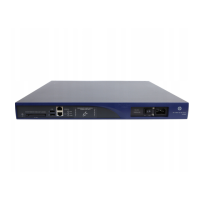
Do you have a question about the 3Com MSR 20-20 and is the answer not in the manual?
| Form Factor | Desktop |
|---|---|
| Connectivity Technology | Wired |
| Flash Memory | 32 MB |
| RAM | 128 MB |
| VPN Support | Yes |
| Firewall | Yes |
| Wireless | No |
| Product Type | Router |
| Product Series | MSR |
| Data Link Protocol | Ethernet, Fast Ethernet |
| Network / Transport Protocol | TCP/IP |
| Remote Management Protocol | SNMP, Telnet |
| Features | Firewall protection, VLAN support, Quality of Service (QoS), DHCP server, VPN support |
| Encryption Algorithm | DES, AES |
| Authentication Method | RADIUS |
| Interfaces | 1 x console - RJ-45 |
| WAN Ports | 2 |
| LAN Ports | 2 |
| Operating System | 3Com Router OS |
Release notes summarize operational requirements and known issues for new 3Com MSR software releases.
Provides website for latest documentation and software updates, and how to obtain guides.
Lists minimum requirements for successful 3Com MSR operation, including chassis, power supply, and modules.
Lists known issues related to system management commands and FTP client behavior.
Details issues with packet dropping, load-sharing counts, CLI command availability, and port mirroring on specific modules.
Describes issues with link auto-negotiation on specific SICs and port mirroring direction.
Covers RIP timer options, packet fragmentation, unsupported NAT ALGs, and DHCP behavior in bridge sets.
Notes missing commands for IPv6 processes and issues with non-existing OSPFv3 IDs and static routes.
States that multicast is not supported with VLAN interfaces and IGMP is not supported in a bridge template.
Indicates that NQA does not support hostnames and requires IP addresses instead.
Details limitations in the `debug mpls` command regarding the display of received hello messages.
Reports that SIP Statistics do not show error events and Attendant Call Transfer fails under busy conditions.
Notes that port-id is not required for configuring a monitor port in a mirror group.
Mentions a specific power cord strain relief clip is designed only for China.
Provides step-by-step instructions for upgrading software using the FTP protocol, requiring level 3 privileges.
Explains how to enter the Boot Menu by pressing Ctrl+B and lists various boot options.
Details managing application files (main, backup, secure) in Flash memory via the Boot ROM menu.
Describes how to change the Boot ROM password.
Explains how to set an ignore flag to use default factory configuration for booting.
Outlines options for upgrading, backing up, or restoring the Boot ROM program.
Explains how to temporarily clear the Super Password.
Briefly mentions device operation, noting it's not typically used with single storage devices.
Details upgrading software via the console port using the Xmodem protocol.
Provides steps for upgrading an application image using Xmodem, including baud rate settings.
Outlines the procedure for upgrading software using TFTP client-server model.
Describes upgrading via an Ethernet interface using TFTP, requiring a TFTP server.